Soondubu Jjigae (순두부찌개) is a hot, soupy Korean stew known for its comforting warmth. It’s often served with meat and seafood, but both are optional; this is a vegan version. It isn’t often you find a dish that is both hearty to eat and light on the stomach! This is a great way to use up your old, overripe kimchi as well. Low-carb and gluten-free.
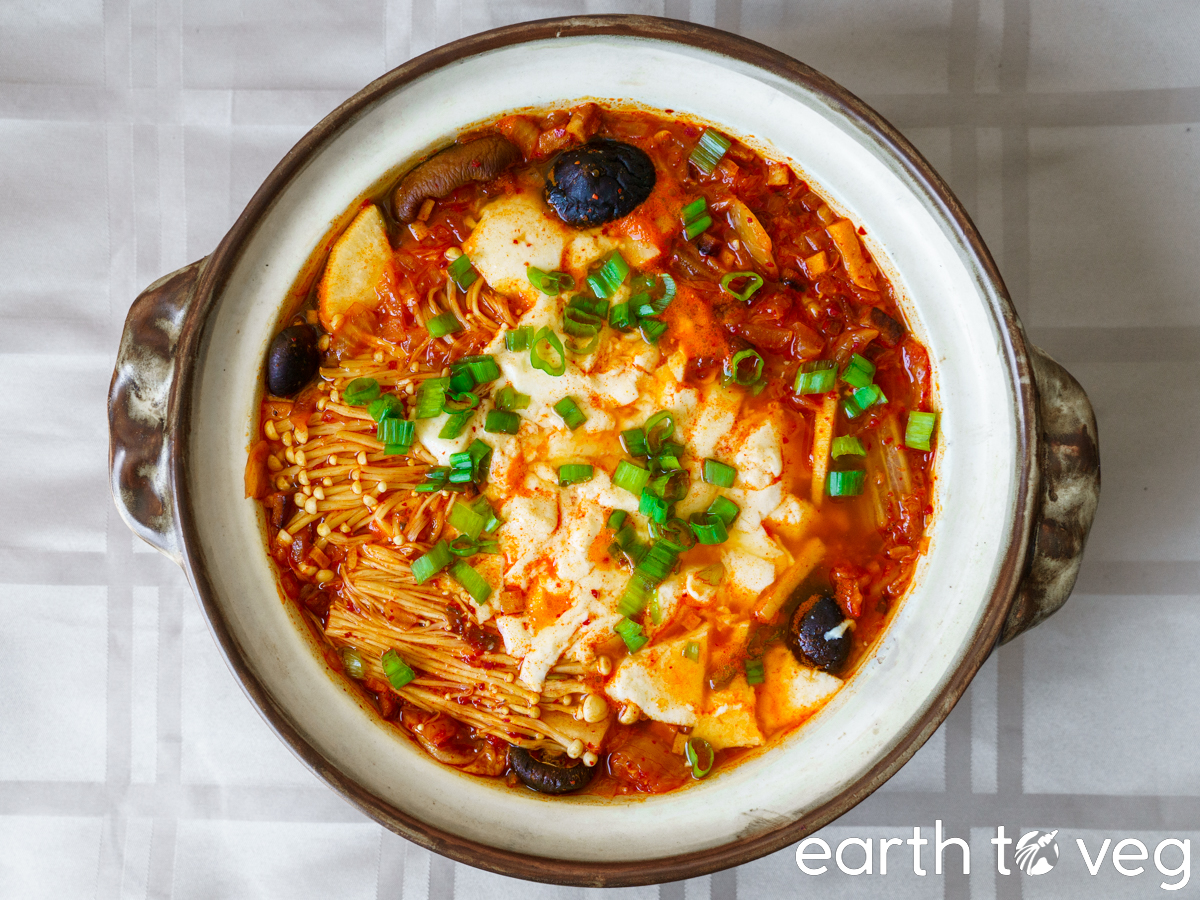
History & Origins
Soondubu-jjigae (also spelled sundubu-jjigae) means “soft tofu stew” in Korean. Soondubu means “pure tofu” which refers to the custard-like, barely-set silken tofu that adds a satisfying creaminess to the bowl. Unlike firmer forms of tofu, this type of tofu is not curdled, and it isn’t pressed to get rid of excess water, resulting in a smooth, delicate, pudding-like texture.
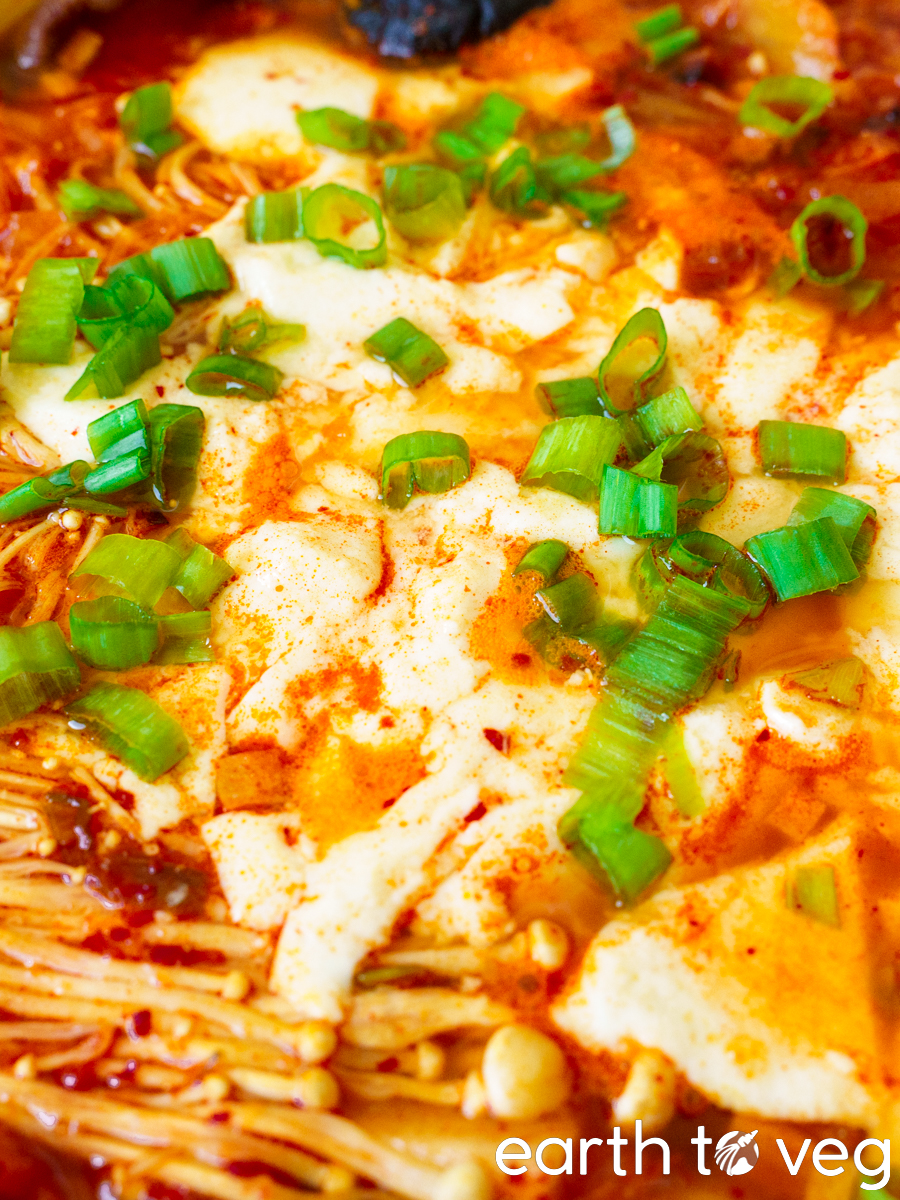
This Korean tofu stew emerged during the Joseon Dynasty of Korea, which lasted from 1392–1897. The exact origins have been lost to time, but it was apparently intended as a meal for elderly people, presumably because of its soft texture. Its popularity later became widespread throughout Korea as a lunch dish.
By the late 90’s, the dish had found favor among Americans as well. Much of this can be credited to the late Los Angeles restauranteur and Korean immigrant Hee Sook Lee. She opened a chain of restaurants called BCD Tofu House in California, introducing soondubu to the masses.
Guk vs Tang vs Jjigae
You will see the words guk, tang, and jjigae in the names of many Korean recipes. No meal in Korea is complete without Steamed Rice (bap), some sides (banchan), and a bowl of guk or jjigae.
Guk (국) and Tang (탕)
Guk means “soup” in Korean. Tang is the same thing, being a loanword from the Chinese word for soup (湯). In practice, guk refers to more simple, vegetable-forward dishes, while tang are heavier and meatier, but this isn’t a hard-and-fast rule.
Compared to jjigae, guk and tang are milder in flavour and saltiness.
Examples of guk or tang:
- Haejang guk (hangover soup)
- Kongnamul Guk (Soybean Sprout Soup)
- Miyeok guk (seaweed soup)
- Naengkongguk (cold soup made with unfiltered Soy Milk and agar noodles)
- Oi naengguk (ice cold cucumber soup served in summer)
- Samgyetang (chicken soup with ginseng and sticky rice)
- Tteokguk (rice cake soup), often served on Korean New Year
Jjigae (찌개)
Jjigaes are thicker, more substantial dishes, more akin to a stew than a soup, although their consistency can vary. They are usually eaten over rice.
Examples of jjigae:
- Budae jjigae (aka Korean army stew, made with every type of canned and instant food from baked beans to sausage to instant ramen)
- Doenjang jjigae (made with a base of doenjang aka fermented soybean paste, a bit similar to miso)
- Kimchi jjigae (quite similar to soondubu, but made with firm tofu and usually features gochujang or doenjang in addition to kimchi)
- Kongbiji Jjigae (made with ground soybeans or okara)
- Soondubu jjigae (this recipe!)
Jjigae is often saltier than guk, because it is typically paired together with mouthfuls of rice.
There was a time when both soup (guk) and stew (jjigae) were considered a must on a respectable dinner table.
– Chang Sun-Young, A Korean Mother’s Cooking Notes
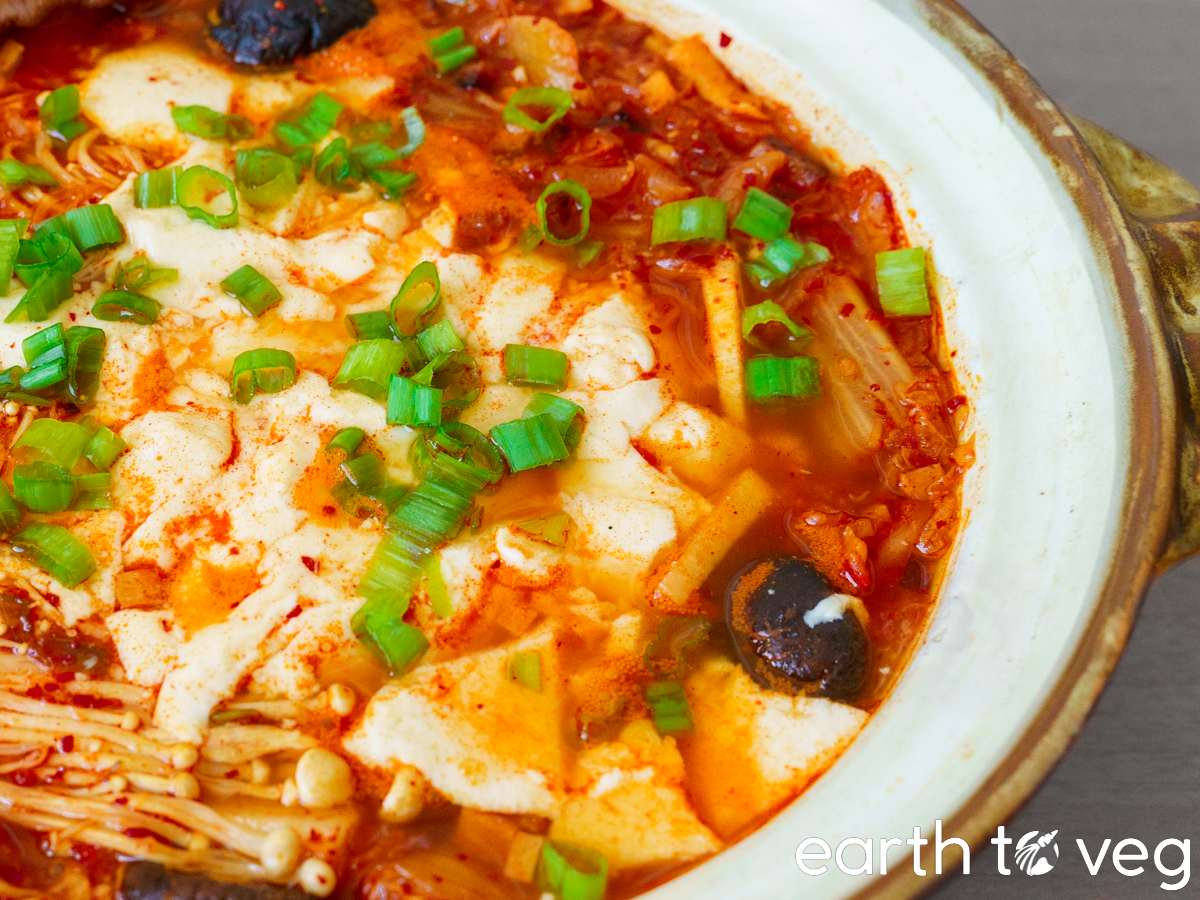
What You’ll Need
When it comes to vegan soondubu jjigae, there are some ingredients that are critical for achieving the familiar flavour and others that are more of an add-it-if-you-can type thing. I’ve broken it down into the essentials and the optional ingredients:
The Essentials
Here are the ingredients that are absolutely essential to make sundubu jjigae:
Dried Kelp, also known as dasima (다시마) in Korean, and more commonly known as kombu (the Japanese name). Traditionally, soondubu-jjigae is made with seafood stock, so dried kelp recalls some of that savoury fishy flavour while remaining vegan-friendly.
- You may see some white powdery stuff on the surface of your kombu. Don’t wipe it off. This is mannitol, a naturally-occurring nutrient that is partly responsible for kelp’s umami flavour. It used to be that kombu was pretty grimy which is why rinsing and wiping was common, but nowadays any packaged kombu you purchase in the store will be clean enough to use without cleaning.
- Wondering what to do with your floppy boiled kombu? Well, I usually eat it plain right out of the pot tbh. But I also recently saw this recipe for a sweet-and-salty kombu side dish which looks hecking GOOD so I might try that next time (sans bonito flakes).
- Instead of whole kelp, you can also use a kombu-based dashi powder, but make sure to check the ingredients because many brands contain fish. I make my own kombu powder at home by grinding up whole pieces of dried kelp in the ol’ Blendtec.
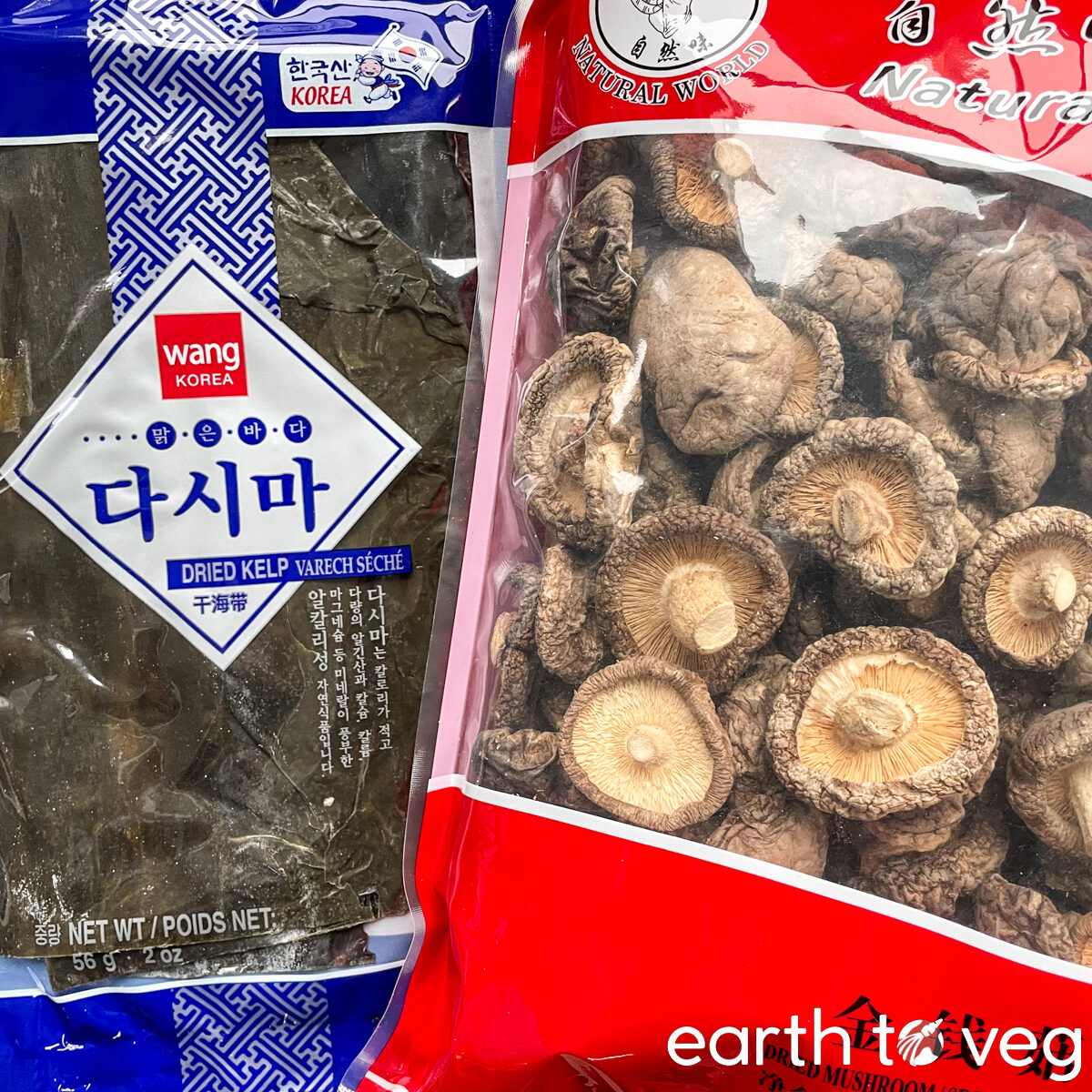
Dried Shiitake Mushrooms are also used to add additional depth of flavour, can you sense a theme here? Sundubu jjigae is really savoury and flavourful and that’s because we are using a ton of umami-packed ingredients, from kelp to mushroom to “fish” sauce to kimchi. To save time, you could also use mushroom powder or mushroom bouillon powder. I like using whole shiitake because well… you can eat the mushrooms later. But using powdered kelp and powdered mushroom can cut down the cook time of this recipe a little bit because you can skip the initial simmering step for the broth.
Scallions. The whites of the scallions are sautéed to make the aromatic base of the jjigae while the green tops are reserved for garnish at the end. If you’re low on scallions, though, you can substitute with finely diced onion or shallot instead.
Garlic is also an aromatic in this recipe. Need I say more? It’s self explanatory!!
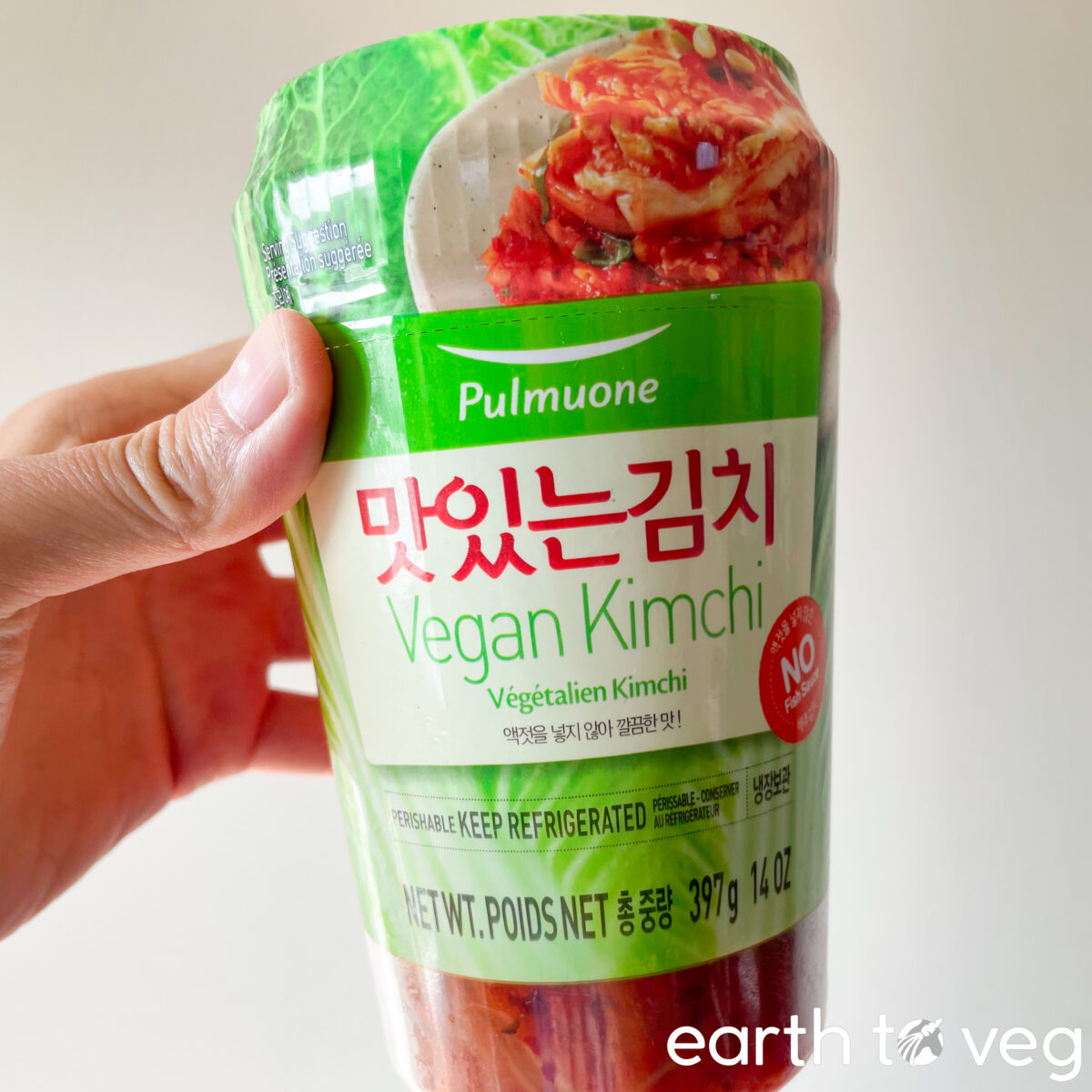
Kimchi gives this stew its spicy-sour taste. If you’re not a fan of raw kimchi, don’t worry, I’m not really either, but its pungent flavour mellows out in the stew and just try it okay. A warm bite of kimchi with silken tofu is just chef’s kiss 🧑🍳 Make sure you get a vegetarian kimchi though. A lot of kimchi is made with anchovy, fish sauce, or shrimp paste. Korean stores usually carry one or two vegan-friendly options. Unfortunately, they’re usually more expensive than regular kimchi—I bought this tiny jar of kimchi from A-Mart for $8.99. Fml 🥲
Gochugaru again is here for the vibrant red colour as well as the heat. You can substitute with Aleppo pepper, they are pretty similar in terms of spiciness. If you don’t have either, you can use regular red pepper flakes, but grind them up a bit in a blender or food processor first. If you want a mild stew, try adding just 1–2 tsp first instead of 2 tbsp.
Silken or Soft Tofu is my favourite part of soondubu jjigae. After all, it is what gives the dish its name. You can often find silken tofu in a tube, but make sure to check the ingredients because many of these tubed tofus contain egg. Another good option is “douhua” or “tofu pudding” which you might see sold in big plastic containers (I use it in my Sichuan Douhua recipe). And if you’ve got extra tofu leftover from making this recipe, why not turn the rest into crunchy Pan-Fried Soft Tofu?
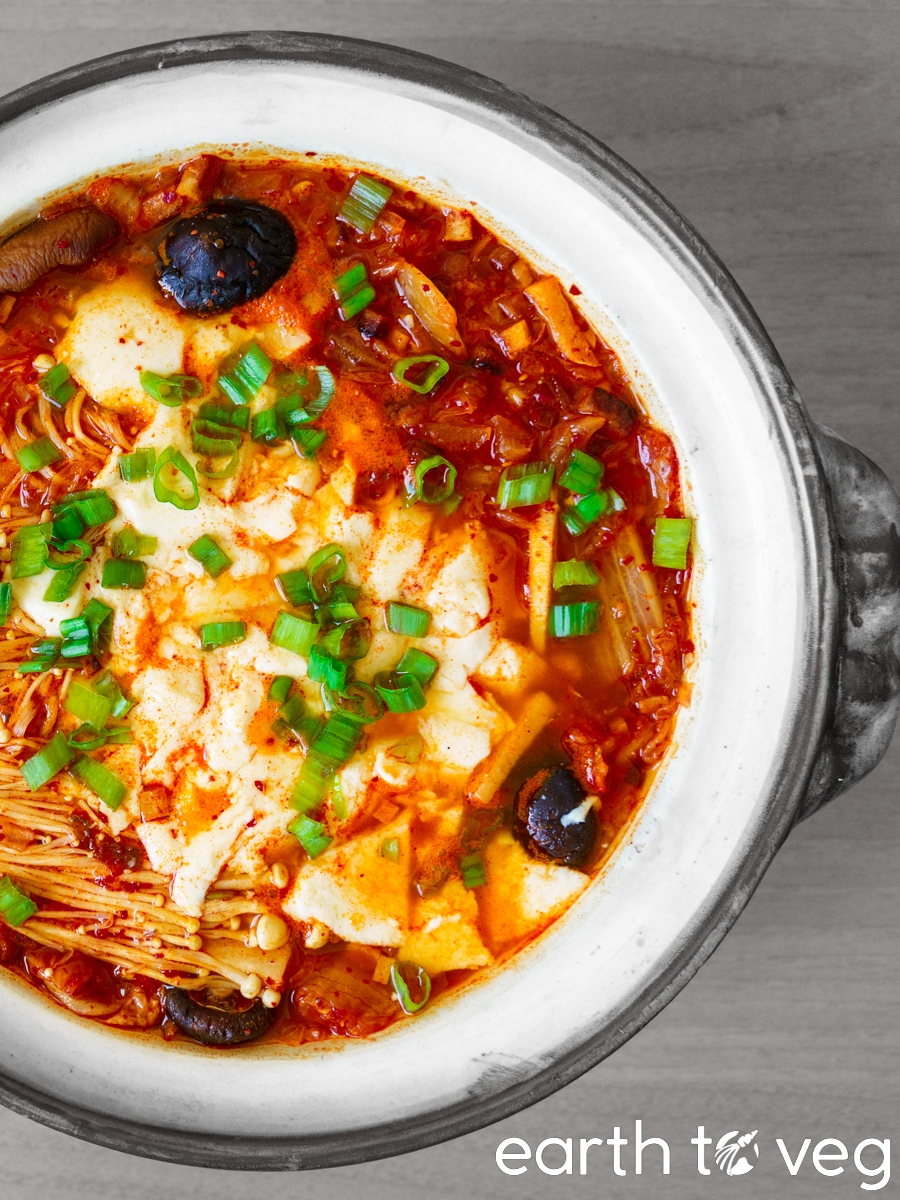
Optional Ingredients
Vegan Pork Belly. I know, I know, vegan pork belly just sounds wrong… But as mentioned above, soondubu jjigae often contains some form of meat. Pork belly is one of the more common options. I stumbled upon some “vegan three tier meat” at my local vegetarian food store, and I was surprised by how well it worked for this stew. Plus, it adds some additional protein. If you don’t have this stuff, feel free to substitute with another vegan protein like TVP, crumbled tempeh, more tofu, or just leave it out entirely. In some of the photos on this page you may notice I have added some veggie balls too (yeah, those things you put in hot pot). Another solid option!
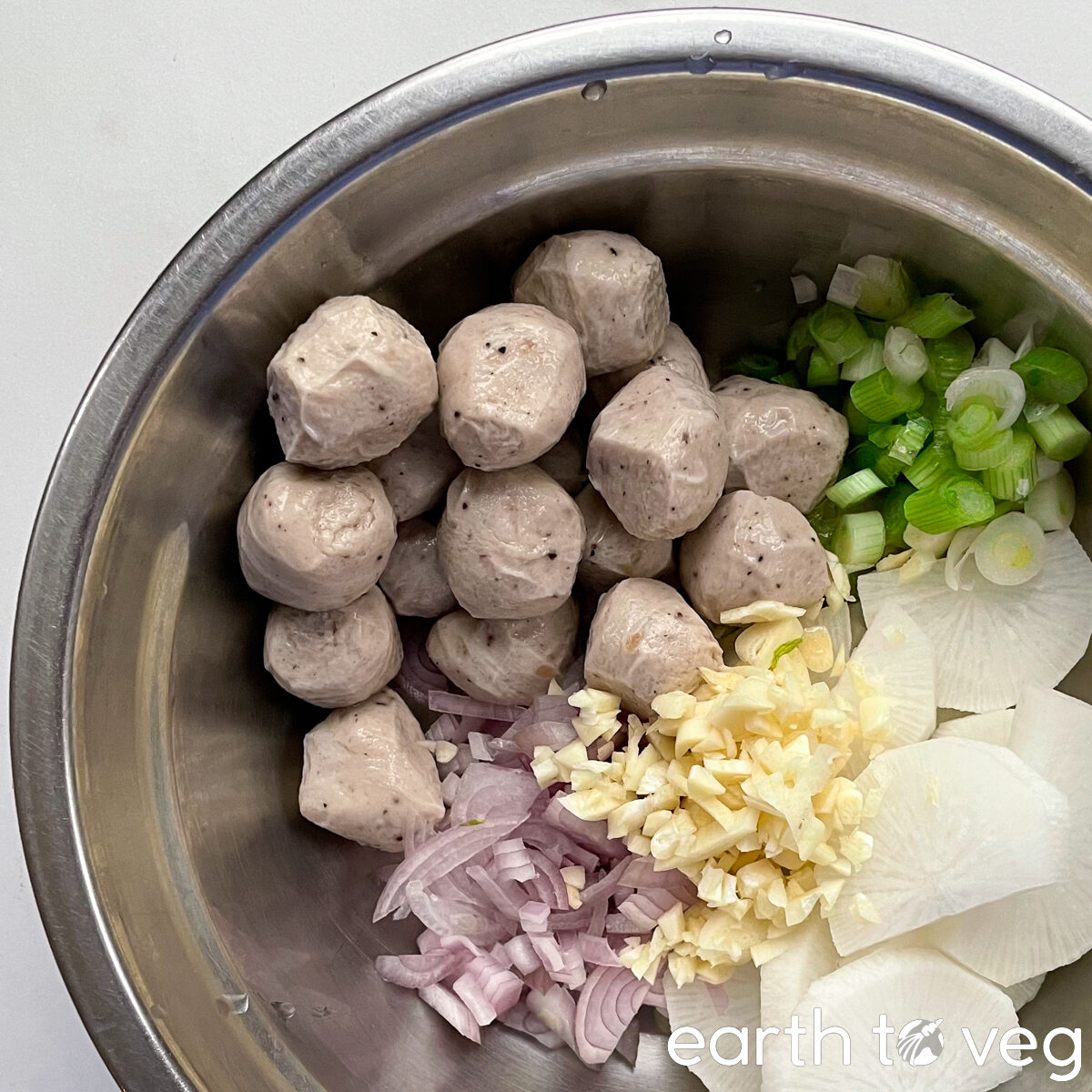
Korean Radish is known as mu (무) and is very similar to daikon radish. So you could use either. It adds an earthy, well-rounded layer to the stew. If you don’t like radish, you could add zucchini, chayote, or even watermelon rind instead. Don’t overcrowd it with vegetables, though; remember the star is the tofu.
Vegetarian Fish Sauce adds a funky sea flavour to the stew base. You can read more about vegan fish sauces in my Vietnamese Tomato Fried Tofu recipe. Can be substituted with soy sauce or salt.
Enoki Mushrooms bring yet another texture to the stew, pairing well with the soft slippery tofu. Again, another optional ingredient.
For a full list of ingredients and quantities, refer to the recipe card at the bottom of this post.
Step-by-Step Process
Let’s take a look at how to make this Korean tofu stew.
Step 1: Make the Stock
Soondubu-jjigae is traditionally made with a seafood stock known as yuksu (육수). We will be making our vegan yuksu with dried kelp and dried shiitake mushrooms.
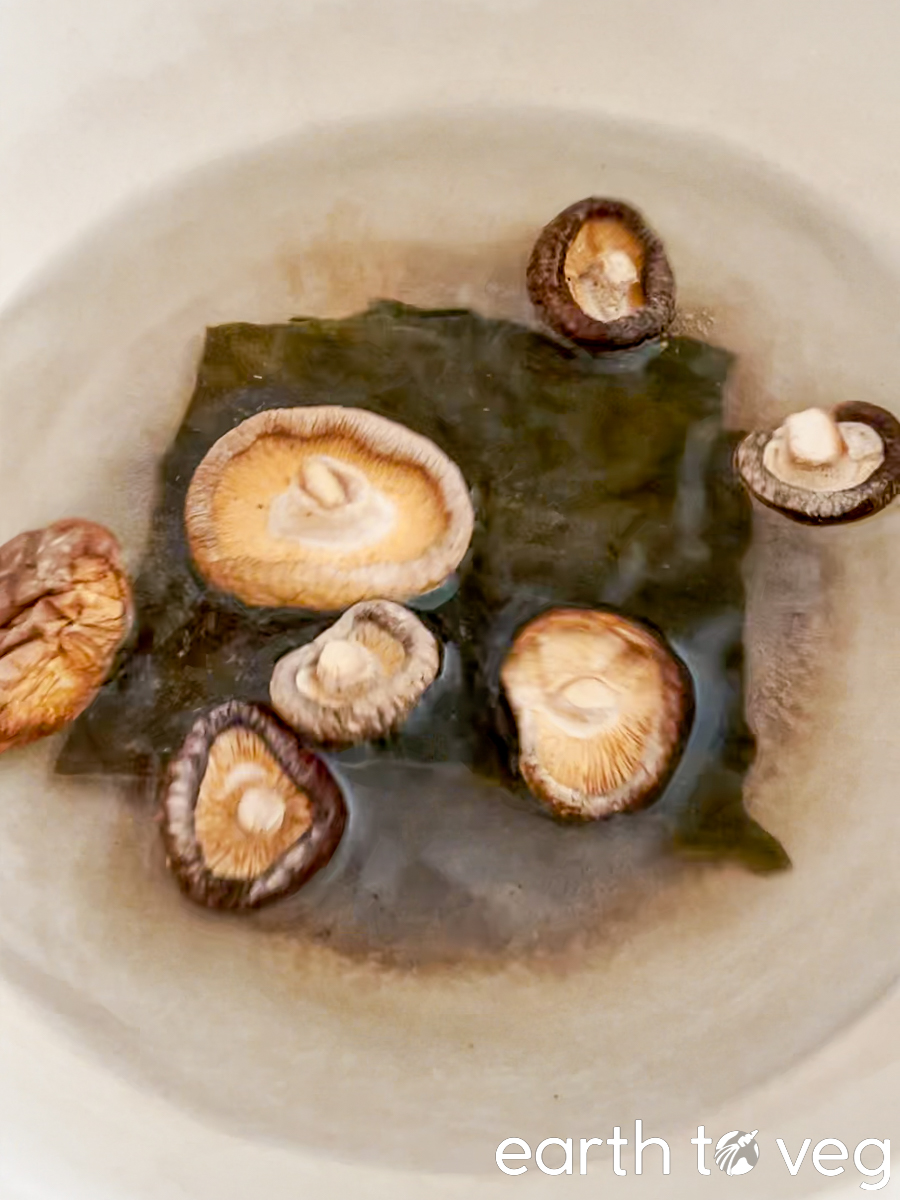
Traditional method: Add kombu and mushrooms to an earthenware pot (ttukbaegi in Korean) along with 2–3 cups water, and turn stove on low. How much water to add depends on your soup consistency preference. Let the stock come to the barest simmer, then cook for 15 minutes. It’s important not to let your stock bubble: the kelp will turn the stock slimy and bitter if it’s boiled.
Overnight method (recommended): You can prepare the stock ahead of time by soaking the kelp and shiitake mushrooms in 2–3 cups cold water overnight, then using the infused stock for the jjigae the next day. (Credit for this “cold brew” method goes to Just One Cookbook.) I prefer going this route because it makes the shiitake mushrooms softer. But I don’t always remember to plan ahead, so the stovetop simmering method is fine too.
Quick method: If you don’t have the time (or patience) to make the stock the old way, you can use kombu powder and mushroom powder. In that case, skip this section and move right on to the sauté steps below, then add the powders along with the sautéed mixture directly to the water.
Steps 2–5: Sauté the Rest
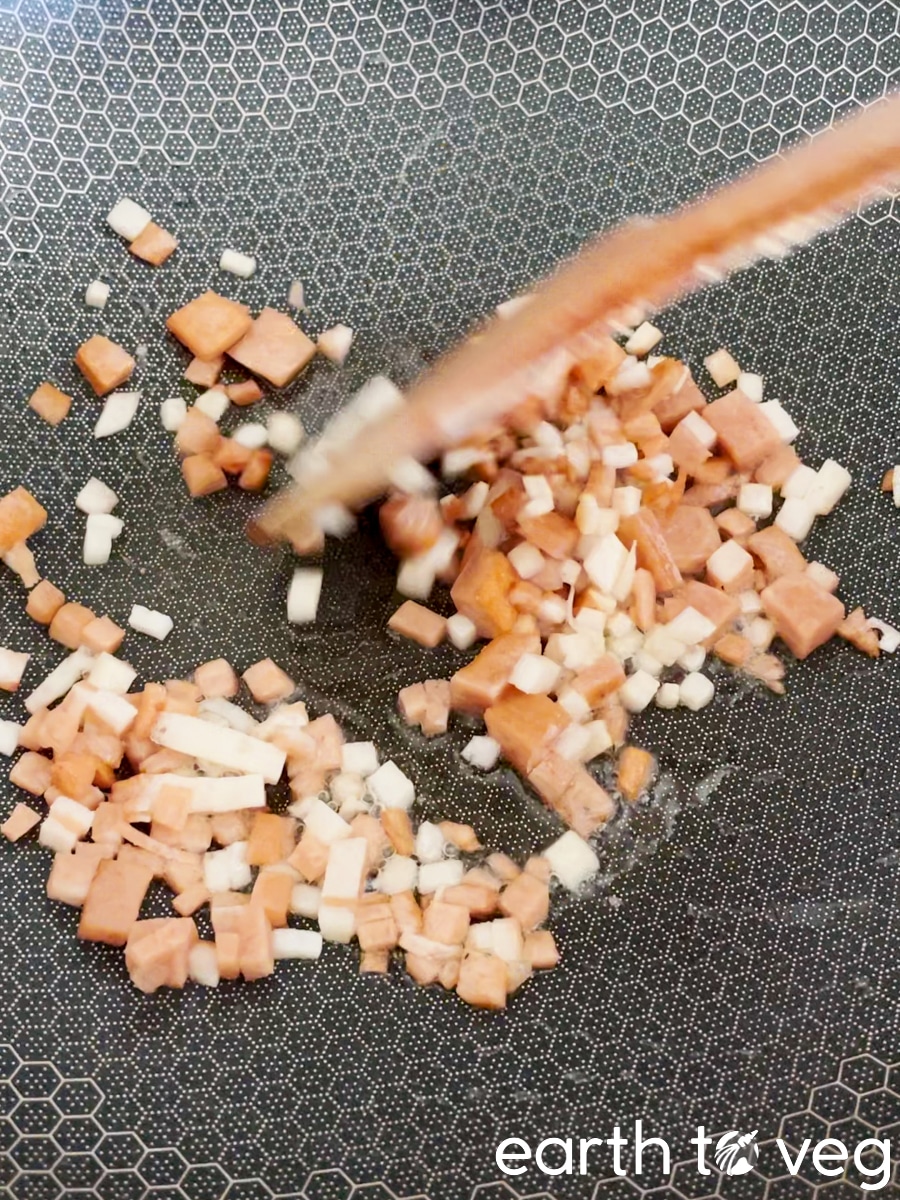
Step 2: Meanwhile, on a second burner, heat up a wok or skillet on medium-high heat. Once hot, pour in the oil and add your diced vegan pork belly (if using). Cook for a few minutes until it browned.
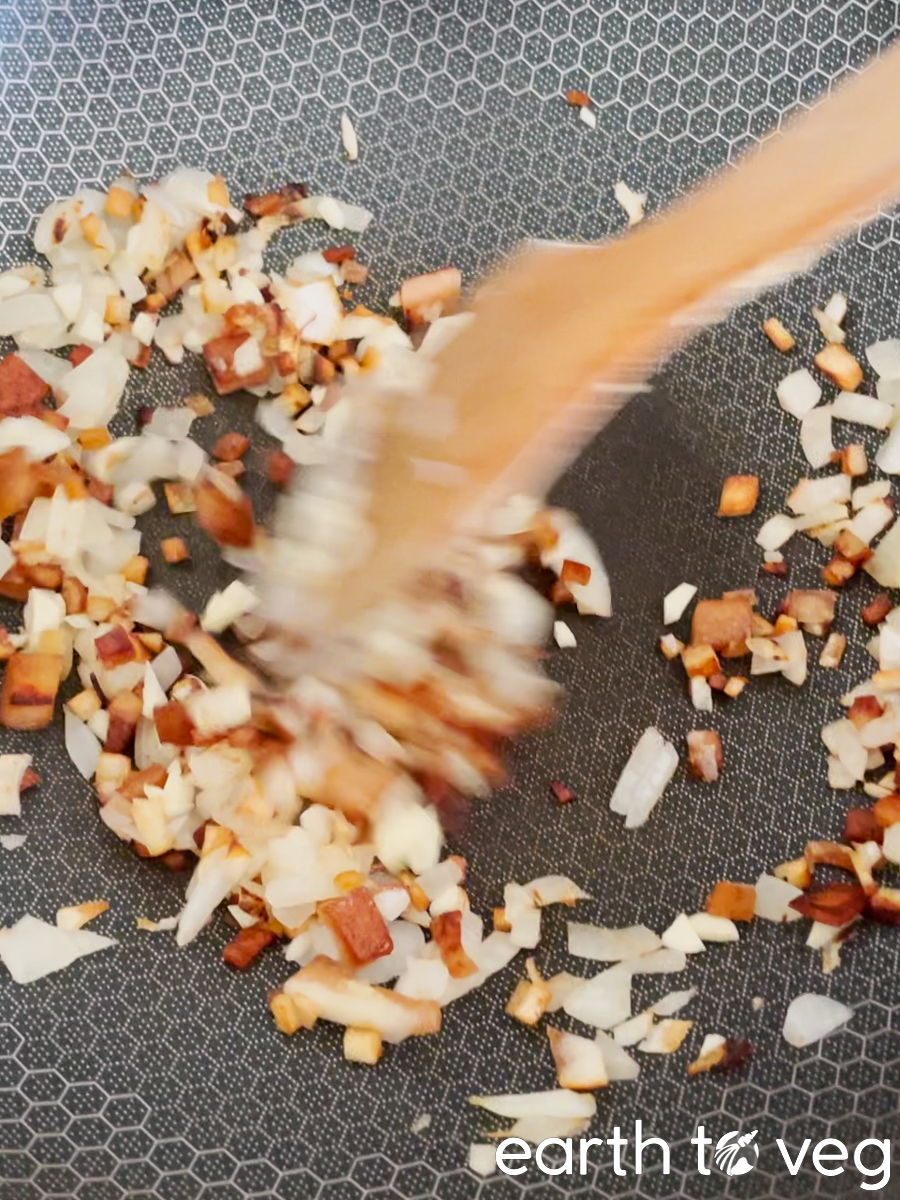
Step 3: Throw in the scallion whites and minced garlic. I am using yellow onions here instead of scallions because I ran out, but I prefer using scallions. Sauté just until fragrant (around a minute); garlic burns easily so be watchful.
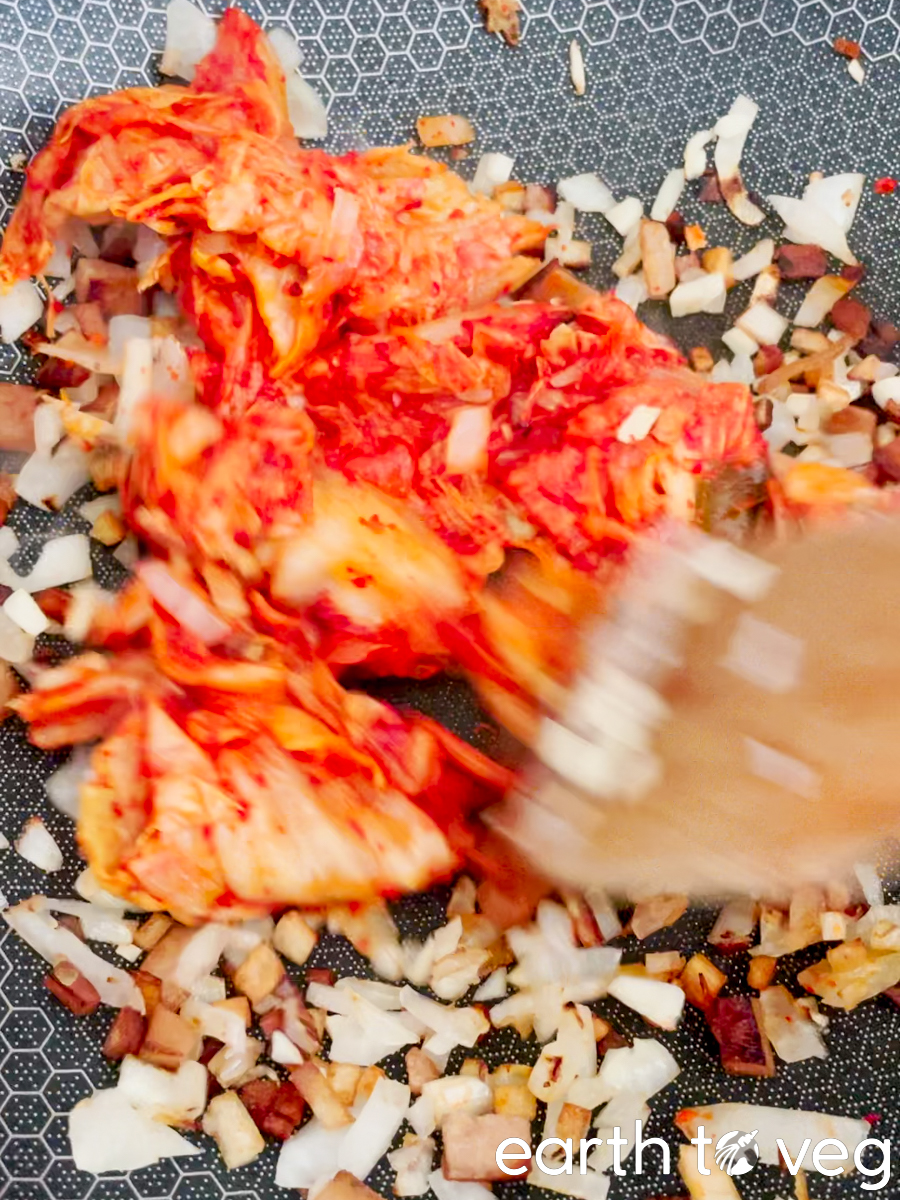
Step 4: Next, add the kimchi and gochugaru flakes.
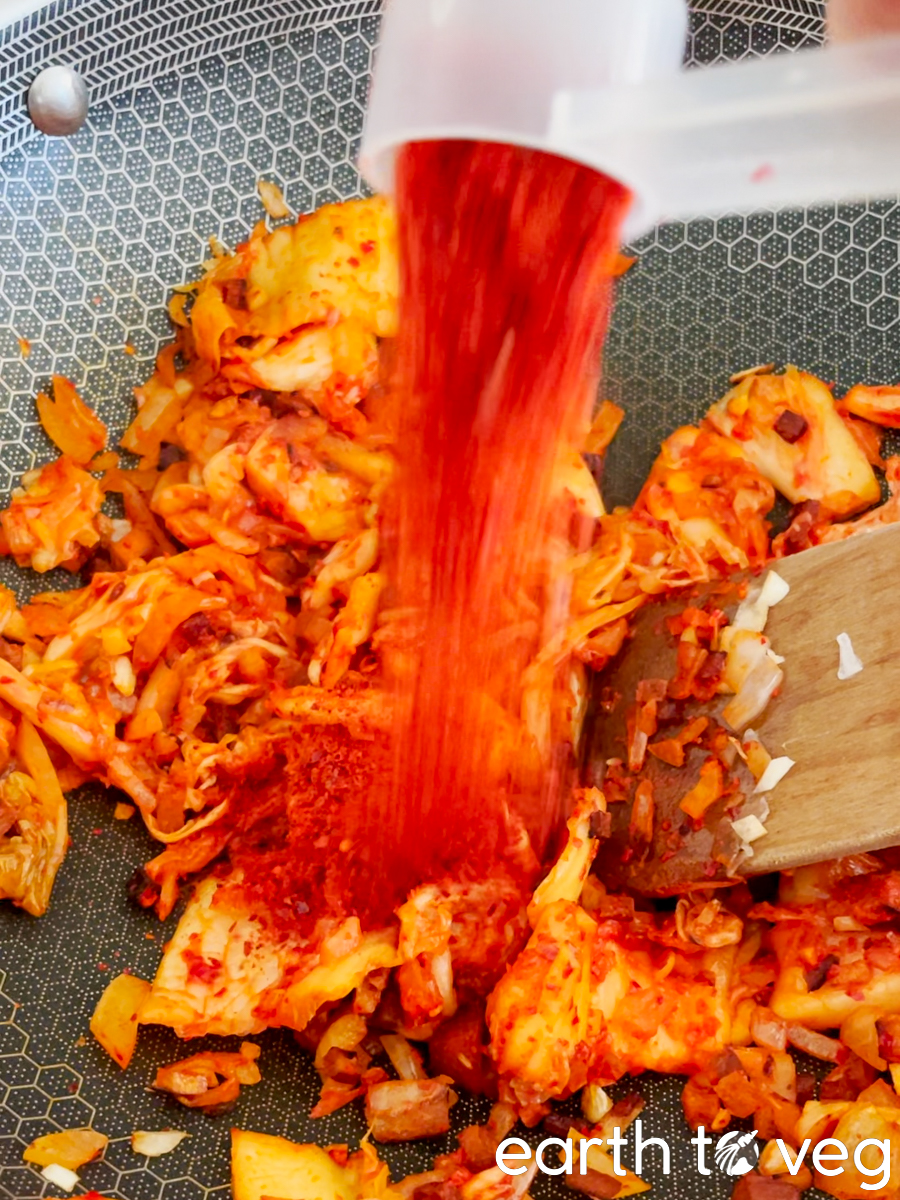
Step 5: Cook for a few more minutes, then turn off the heat.
Steps 6–11: Bring It All Together
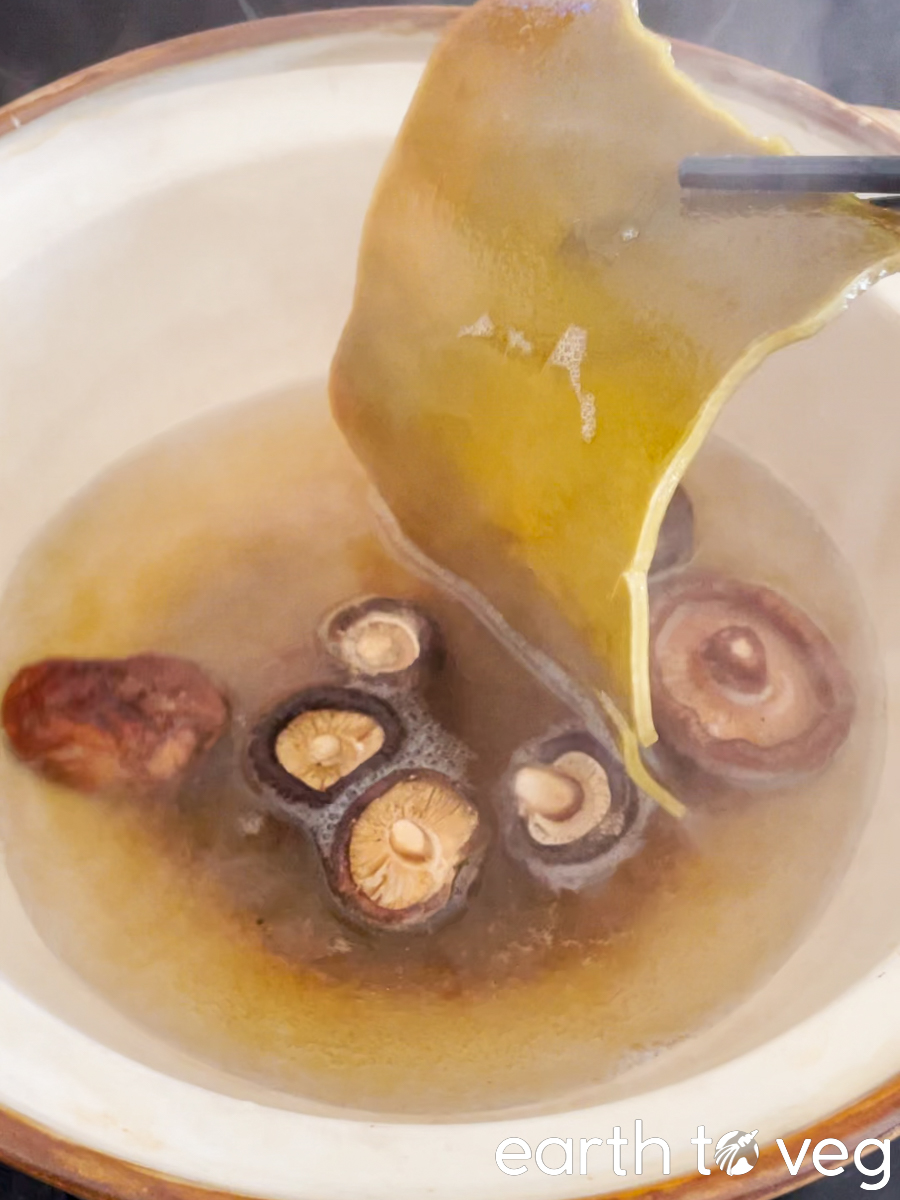
Step 6: Now that the yuksu stock has cooked for around 15 minutes, remove the kelp (see FAQ for ideas on what to do with it).
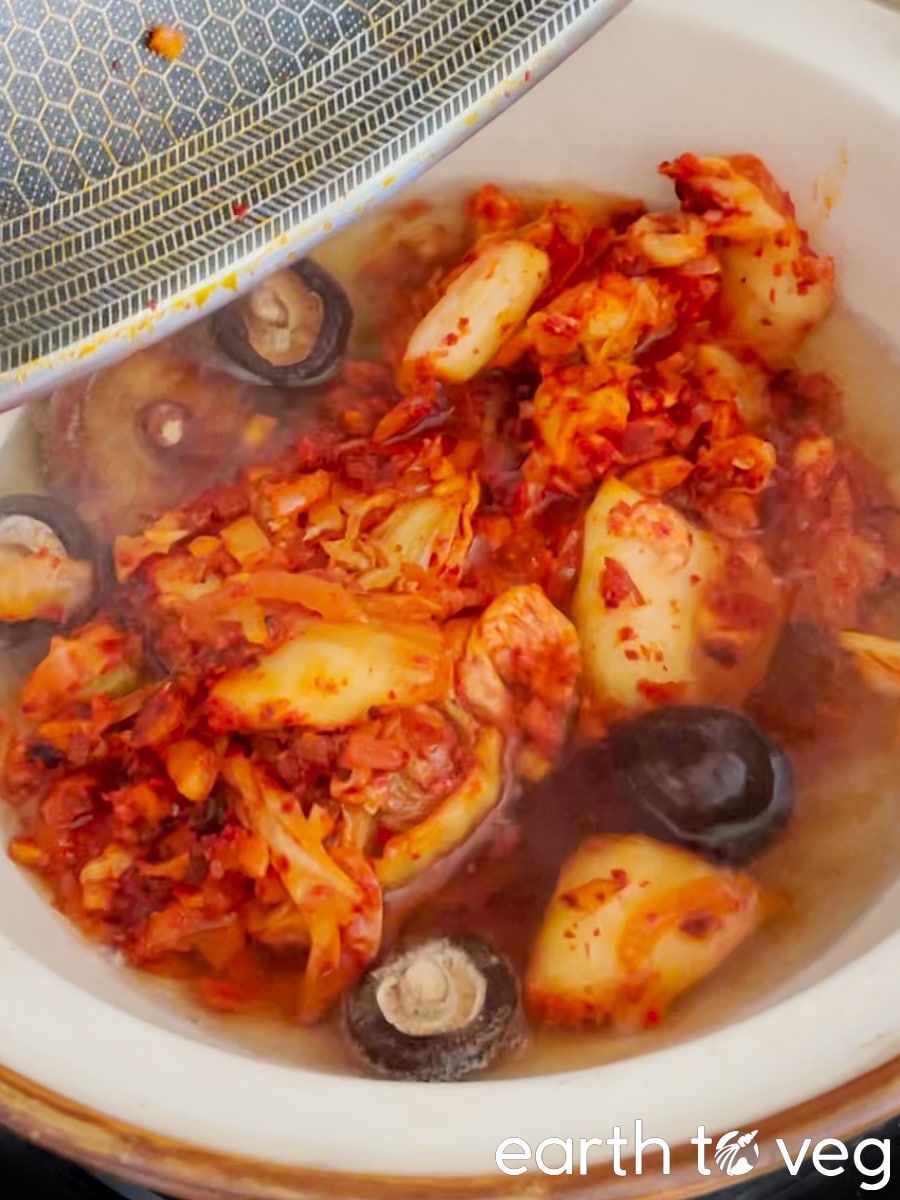
Step 7: Turn the heat on the stock pot up to medium. Dump all of the sautéed kimchi mixture into the yuksu broth.
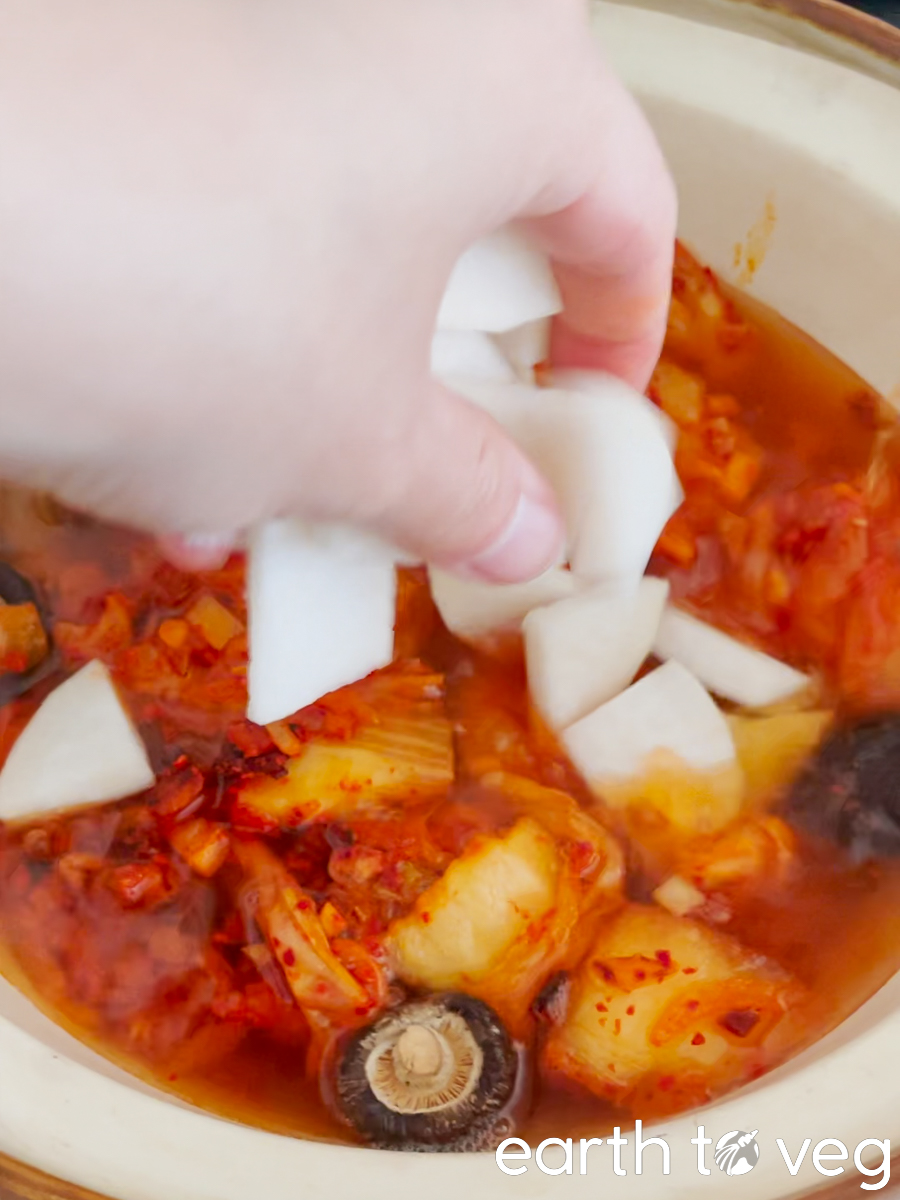
Step 8: Add radish slices. Season with vegan fish sauce (or soy sauce, or salt to taste).
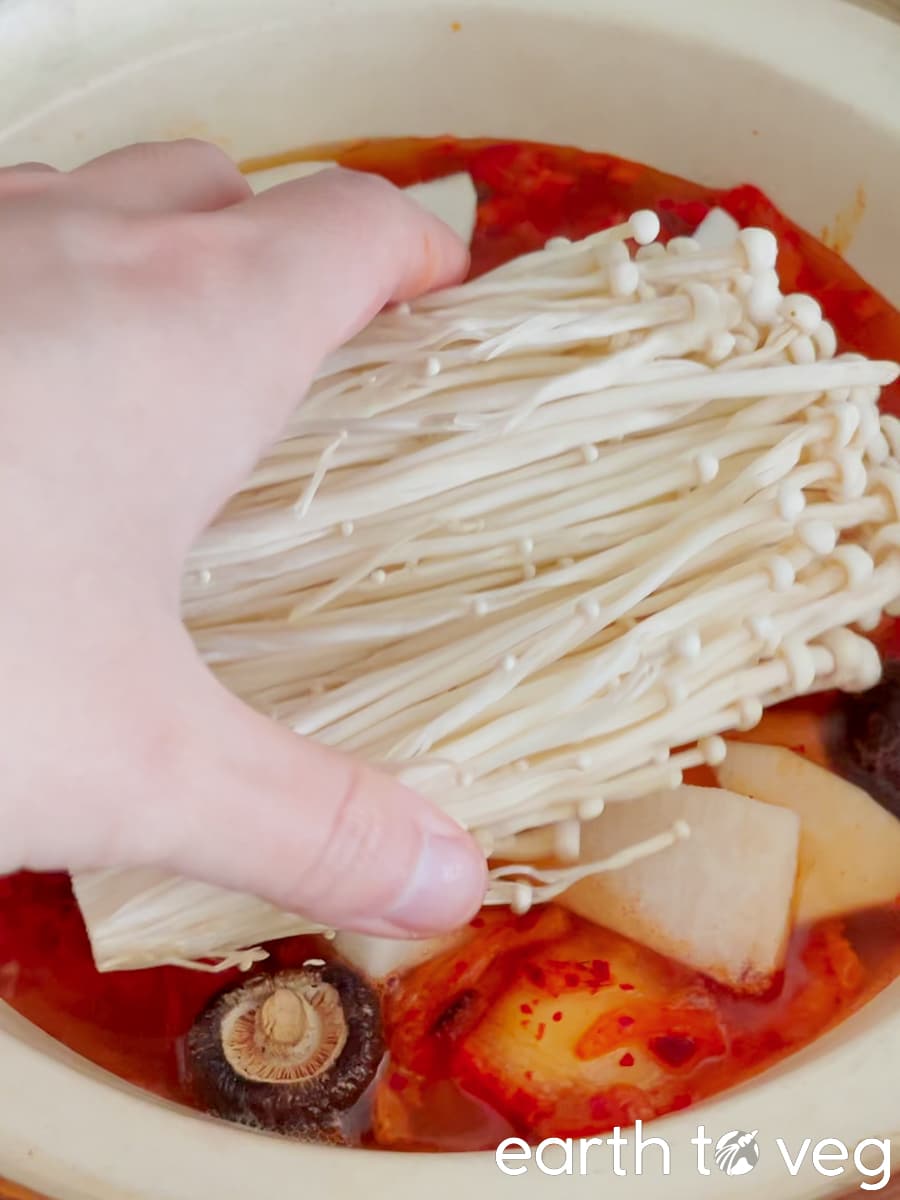
Step 9: Gently nestle enoki mushrooms (if using) into the broth. Cover and bring to a gentle boil.
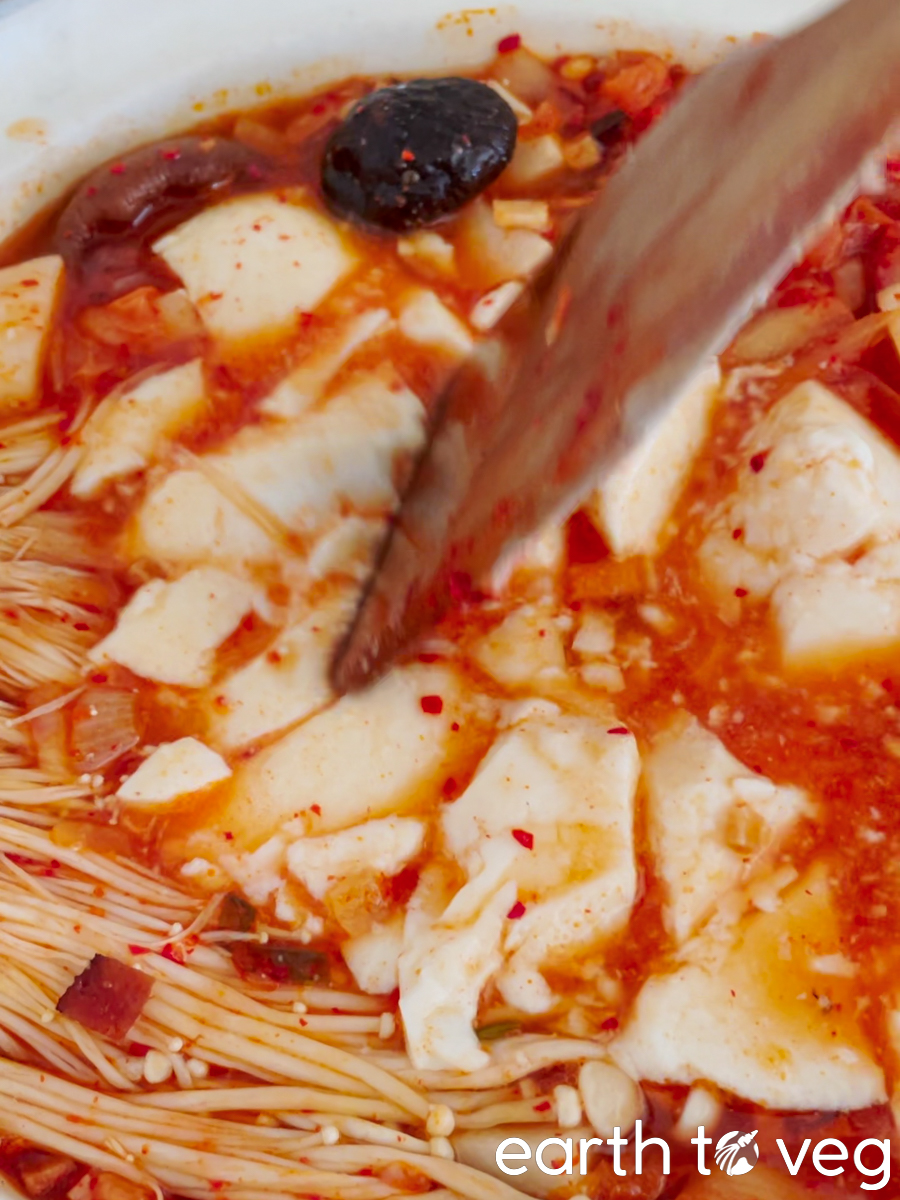
Step 10: Leave it to bubble for 20 minutes, then put in your tofu. Using a wooden spoon or spatula, gently break up the tofu into smaller chunks. But not too small. Cover the pot again, and turn off the heat.
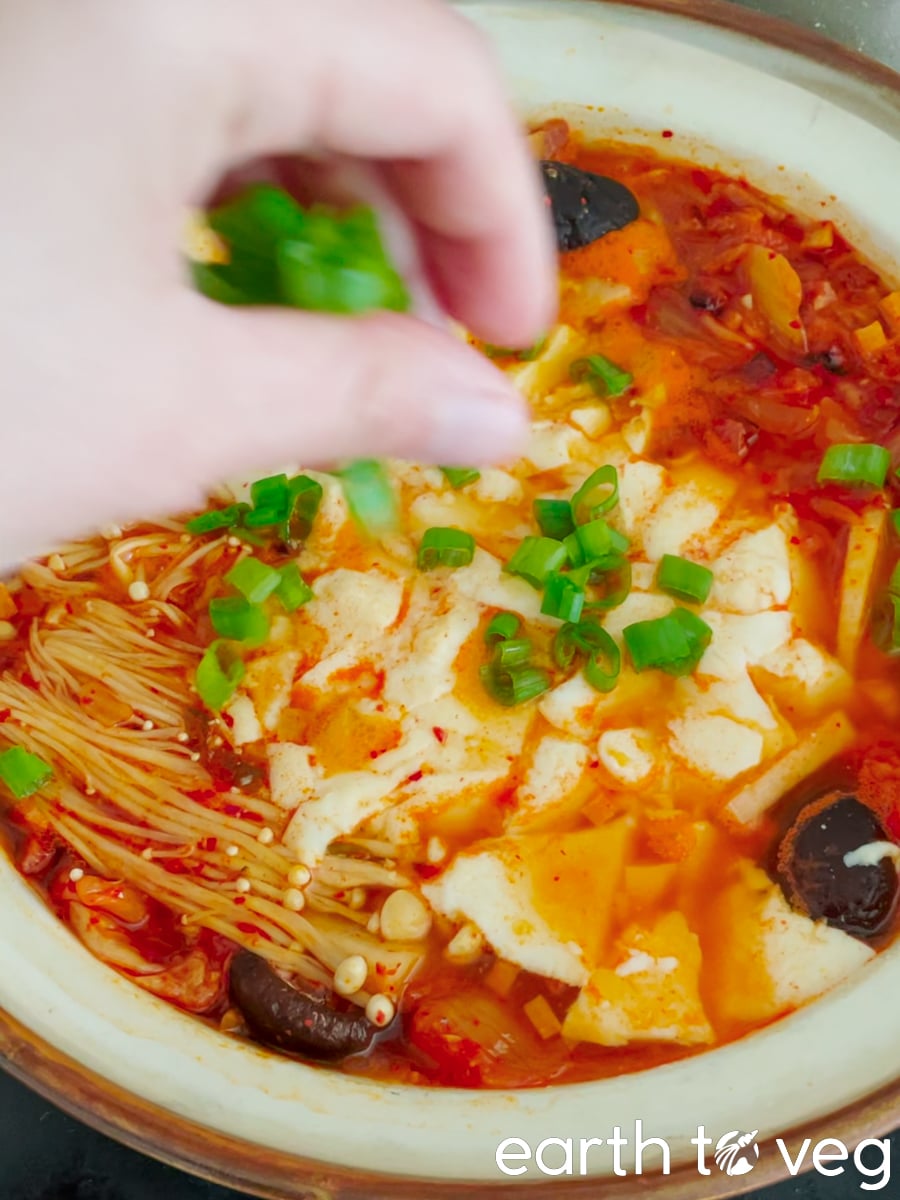
Step 11: Let the stew continue to cook in the residual heat for another 5 minutes. Taste for seasoning, adding more salt and gochugaru if desired. Scatter the scallion greens over top. And serve immediately!
Ttukbaegi: The Korean Earthenware Pot
If you’ve ever been to a Korean restaurant you’ve probably seen this type of pot. Ttukbaegi (뚝배기) is a thick-walled cooking vessel made of clay. Like a Dutch oven, it’s good at retaining heat, so it’s perfect for making soups and stews and keeping them hot. It also looks beautiful at the table. If you own a ttukbaegi, this is a great time to bring it out.
You can also use a donabe (土鍋) which is sort of the Japanese equivalent. I am using a shaguo or “sand pot” (砂锅) which is a similar concept but Chinese. There are similar clay pots used in other Asian cuisines as well. I guess we all share some kind of interest in earthenware cooking lol!!
Make Ahead & Storage Tips
You can store vegan sundubu jjigae in the fridge for up to five days after cooking. I don’t recommend freezing this recipe. The texture of tofu changes after freezing.
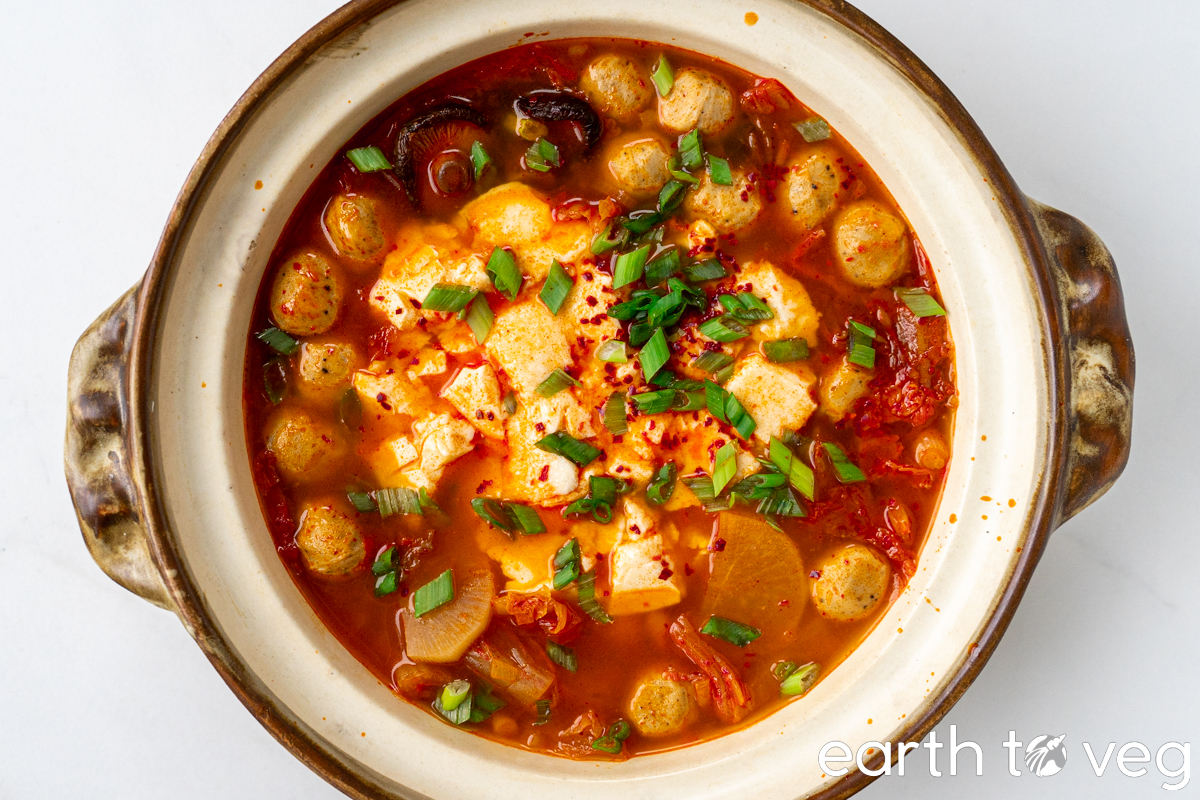
Recipe FAQs
Soondubu jjigae is usually served with steamed rice. You can take a spoonful of soup, add it to a bit of the rice in your bowl, and eat a mouthful of jjigae-rice together like that. OR you can do the opposite, ie. put some of your rice into the soup, eat it up, then add more rice, and repeat. If you’re eating soondubu jjigae on its own with no rice (which I do pretty often when I’ve already consumed way too many carbs for the day), you can just ignore all of that and enjoy by itself! Make sure to get some tofu in each bite, that’s the best part!
Jjigae means “stew” and it refers to a large category of Korean stews that are typically made with a variety of ingredients. Soondubu (also spelled sundubu) refers to silken tofu and is the namesake of a particularly popular stew called soondubu jjigae or tofu stew. Soondubu-jjigae is only one variety of Korean stew out there; there are many other ones such as doenjang-jjigae and budae-jjigae.
So if you’ve been to an Asian supermarket you might’ve seen this stuff called “fresh tofu” which looks somewhere between a soft and medium-firm tofu. It’s not ideal for this recipe because it is a type of curdled tofu (it doesn’t have the smooth silky texture that makes uncurdled tofu so amazing). It also doesn’t look nearly as pretty when you break it apart. BUT it’s better than nothing, so if you don’t have soft or silken tofu available, go ahead and use it! I wouldn’t use anything firmer though (like firm or extra-firm tofu) because the texture is just too different; those are better suited for recipes like Jajangmyeon or Kaeng Pa.
Use it to make a quick side dish to go with your jjigae! Check out this recipe (Korean) or this one (Japanese).
In Korean, “sundubu” (순두부) translates to “pure tofu” or “soft tofu” and it refers to silken tofu which has a delicate, custard-like texture. Sundubu is commonly used in Korean cuisine, particularly in dishes like soondubu jjigae (soft tofu stew) where it serves as the main ingredient.
More Korean Recipes
Recipe Card
Did you make this recipe? Please consider leaving a rating below to let me know how you liked it.
You can also take a picture and tag me on Instagram @earthtoveg, I will shout you out in my Stories!
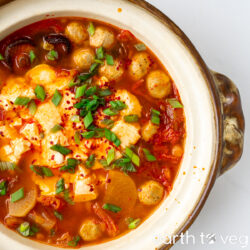
Vegan Soondubu Jjigae (Korean Soft Tofu Stew)
Use Imperial/Metric buttons below to toggle between volume vs weight measurements. I recommend weighing out your ingredients for best results.
Equipment
- Earthenware pot (ttukbaegi) (or a stockpot or Dutch oven)
- Skillet or wok
- Wooden spatula
Ingredients
- 1 piece dried kelp aka dasima 4×4 inches *can sub 1/2 tsp kombu dashi powder
- 5 dried shiitake mushrooms *can sub 1 tsp mushroom powder
- 2–3 cups water see Note 1
- 1 tbsp cooking oil
- 4 oz vegan pork belly, diced *optional
- 3 cloves garlic, minced
- 6 stalks scallions, diced with greens and whites separated
- ¼ small Korean radish aka mu or daikon radish, sliced into rounds then quartered *optional
- 1 cup vegan kimchi
- 1 tbsp gochugaru start with 1/2 tbsp for a milder version *can sub with Aleppo pepper
- 1 tbsp vegan fish sauce or light soy sauce plus more to taste
- ½ lb enoki mushrooms *optional
- 1 lb silken tofu
Instructions
- Add kelp, shiitake mushrooms, and water to a stockpot. Heat on low, maintaining the barest simmer, for 15 minutes. (You can skip this step if using powdered kelp and mushroom. Instead of simmering, you could also soak the kelp and mushrooms in the water overnight; see detailed
Step-by-Step Process above.) - Meanwhile, in a skillet on high heat, add oil and sauté the vegan pork belly until browned. Add garlic and the white parts of the scallions, sauté a minute further.
- Add radish, kimchi, and gochugaru and cook for a couple more minutes.
- Remove the kelp from the simmering water and turn heat up to medium. Transfer the contents of the skillet into the stockpot.
- Add enoki mushrooms (if using) and vegan fish sauce (or soy sauce). Cover and boil gently for 20 minutes.
- After 20 minutes, put in the silken tofu. Gently break it up with a spatula. Turn off the heat, and cover again for 5 minutes.
- Taste and adjust for salt. Top with scallion greens. Serve piping hot!
Notes
- The consistency of jjigae is a matter of personal preference. Use 2 cups of water for a thicker stew, or 3 cups for a thin, soupy consistency.

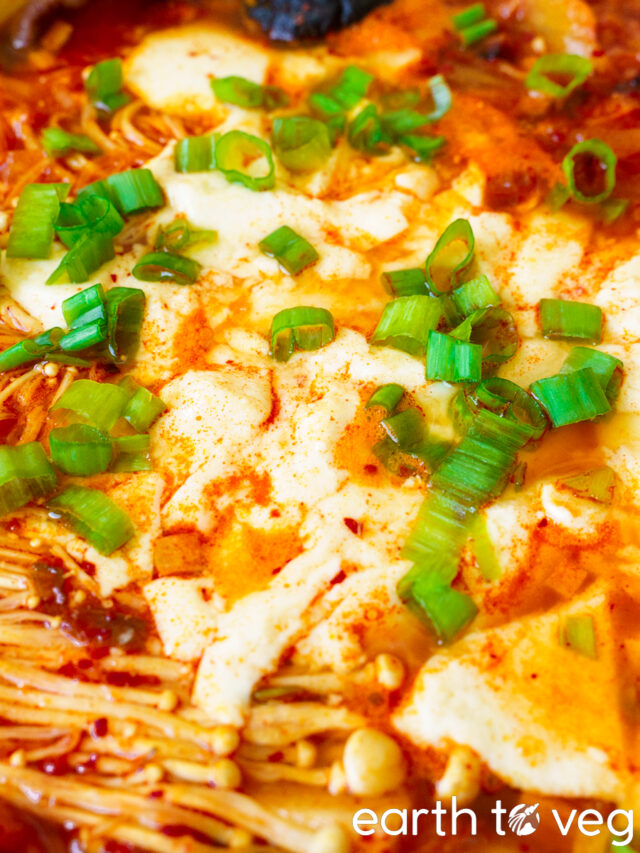
sosoo yummy. thank you! i did not have vegan fish sauce used salt instead. i will have to try it with fihs sauce!
When I’m out of veg fish sauce I use soy sauce, works in a pinch 🙂